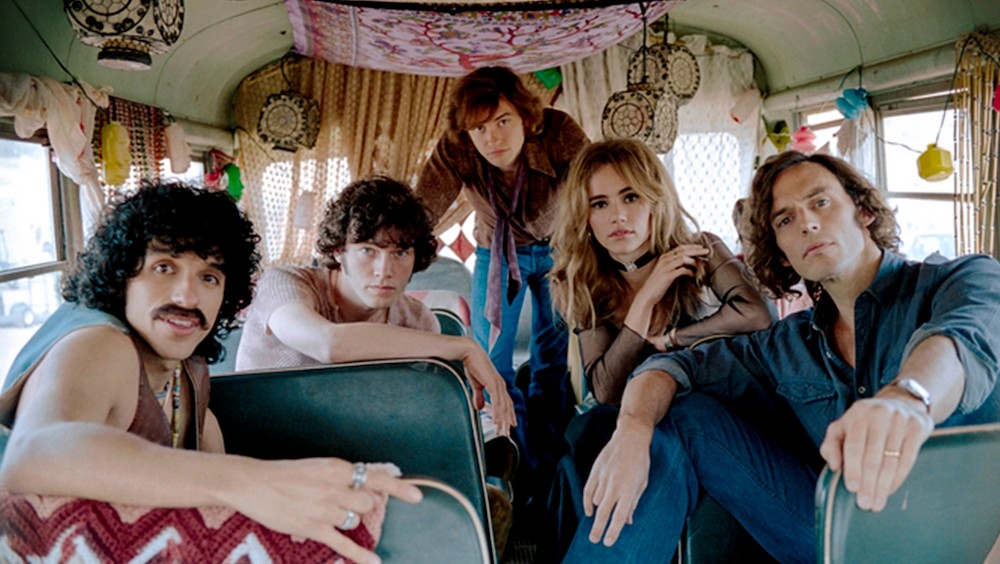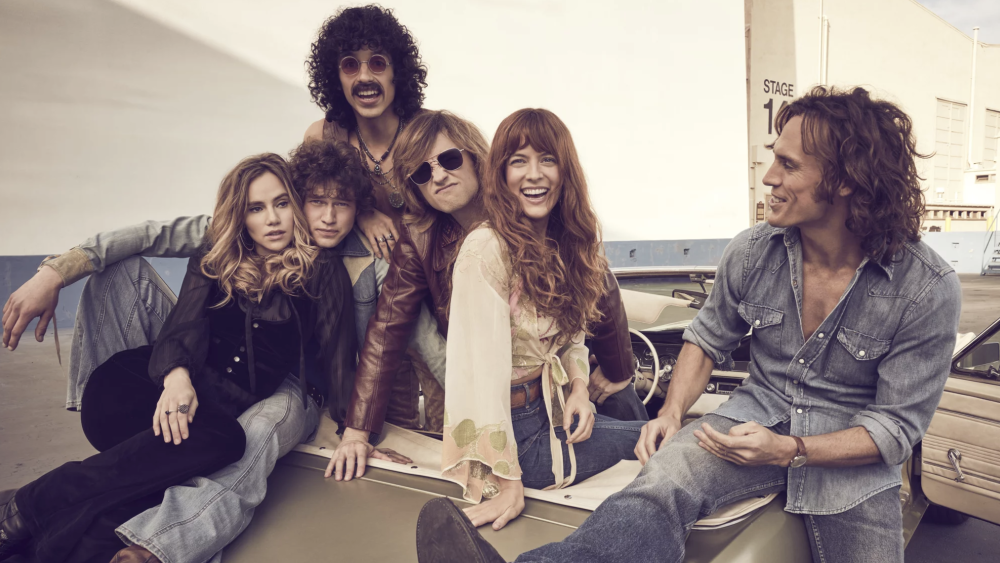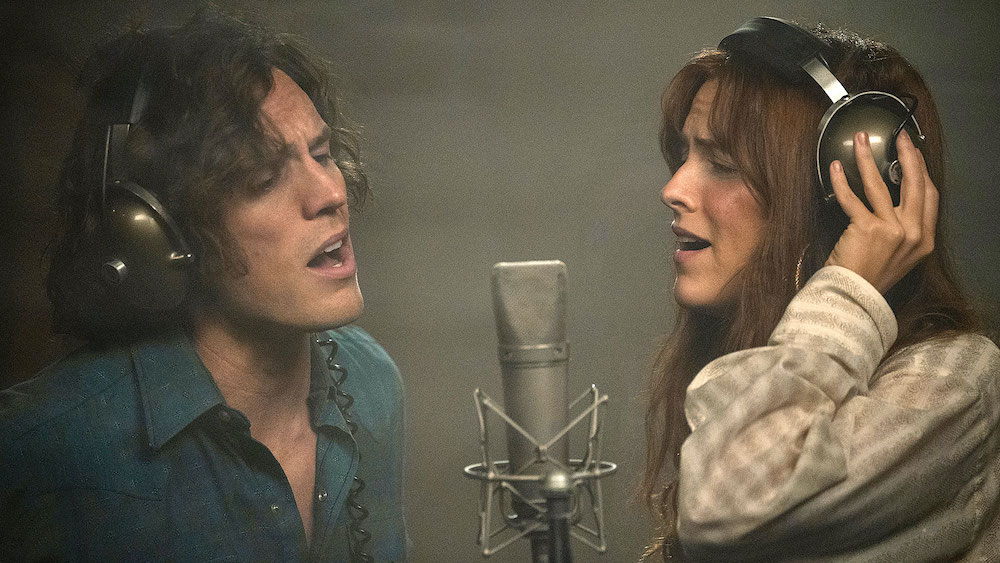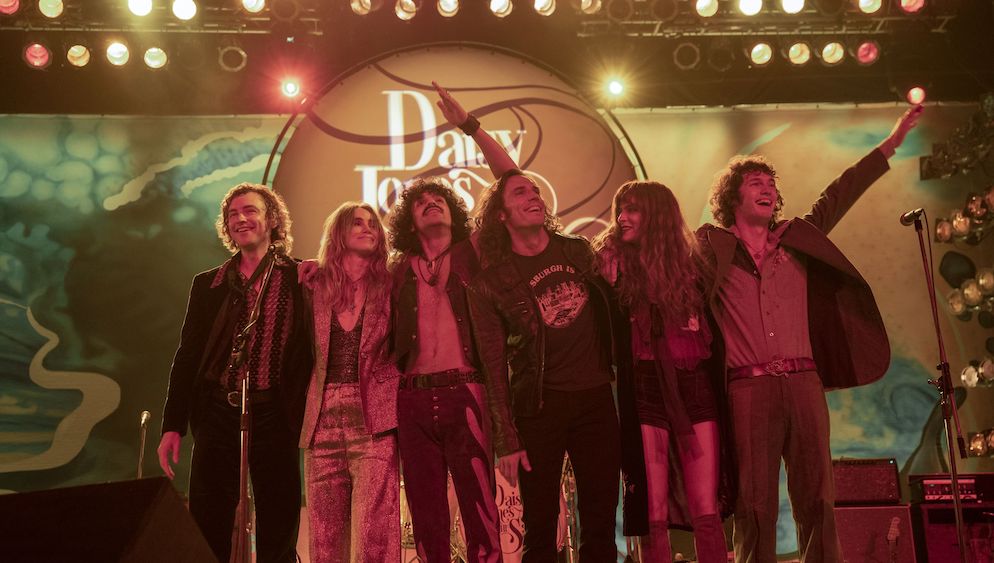
Hairstyles, hair, and makeup can define eras – in real life and in our favorite television shows and movies. It’s always a blast when period productions get it right, and thanks to the combined efforts of MaryAnn Hennings, Rebecca Wachtel, and their teams on Daisy Jones & the Six, the popular Prime Video drama most definitely got it right, lending the series an air of authenticity that transported viewers back to the late 1960s, the 1970s, and the 1990s, as the members of the titular band – played by Riley Keough, Sam Claflin, Suki Waterhouse, Josh Whitehouse, Sebastian Chacon, and Will Harrison — came together, rose to fame, fell apart, and looked back decades later.
Hennings, whose credits span 30 years and include Hearts Afire, Yes, Dear, Modern Family, Brooklyn Nine-Nine, and Where the Crawdads Sing, served as Hair Department Head. Makeup Department Head Wachtel previously worked on Master and Commander: The Far Side of the World, Nip/Tuck, Diary of a Future President, and Truth Be Told.
Below the Line recently caught up with Hennings and Wachtel via Zoom and engaged them in a detailed conversation about their influences, the challenges and joys of working on an ambitious and time-jumping show like Daisy Jones & the Six, and their respective next projects.
[Note: This interview has been edited for clarity and length]
Below the Line: What were a couple of your personal favorite iconic looks from years ago, whether it’s celebrities who are musicians, movie stars, or models?
MaryAnn Hennings: Farrah Fawcett and Brigitte Bardot. Anything Charlie’s Angels. That was it. The ’70s were more a feeling of being free, like the hot roller look with a lot of volume and bounce, and the curtain bangs. Farrah Fawcett, yes, made it famous, but once she did it that was it. It was also the look of Cher; the parting down the middle, the straight and flat, which is polar opposite. The headbands and the scarfs; it was more a description. Everybody owned it. That’s what was great about the ’70s, and the look of the 70s. Everybody had their own version. It was adding flowers, beads, or headbands. It was the rules you followed with the curtain bangs and the hot rollers, but you made it your own – just like they did with clothing.
Rebecca Wachtel: The first thing that comes to my head are the ’20s and ’30s. I like that era. Clara Bow and way back. I don’t know, that’s a hard question because there are so many great looks within every era. I love how they shift and change. I don’t know if I can pinpoint one specific thing.
I enjoy getting to delve into an era and do all the research; just immerse myself into all of that. For me, that’s something that I thrive off of. It’s inspiring. For the ’70s, hair for sure. Makeup, it was such a wide variety because you had so many things happening between disco and hippies. I love all of it. It’s hard for me to pick. That’s why my head went to the ’20s and ’30s. In general, I’ve always loved that time.
BTL: MaryAnn, how crazy was it that, in that era, men – especially male rock stars and movie stars – sported hair as or more luxurious than some of the women? Peter Frampton, the Bee Gees, Robert Plant, Andy Gibb all come to mind…
Hennings: Yeah, I was a huge rock follower in the later ’70s. I’ve been to all those places we shot. I’m so mad at myself for not scraping my initials into the wall like everybody else did. When I started this project, the first thing I thought of was the men: the rock stars with that big, great, hair teased. It was all about slinging their hair around and being sexy. Then I read the script, and I was like, “That’s not these guys.” These guys are a band in a garage. They’re best friends and became the biggest rock stars in the world. Their lead singer never even wanted to be in the band; they just worked him in. I wanted to keep Billy who he was. He had longer hair, but he’s not going to grow it. I even put extensions in it as a test and we were laughing so hard. It would never work. It just wasn’t who he was.

BTL: Rebecca, what led you into makeup business?
Wachtel: I got into the business because I love to do makeups, specifically because I love creating characters. I like the psychology behind characters and then asking the questions, “What would this person look like? How would they present themselves to the world? What are the choices that they would make?” That’s what I love about makeup and makeup design. I started in theater as a kid, and I used to act in theater. That’s where I ended up liking the psychology part of it, but I enjoyed creating characters, so it segued more into makeup and the aesthetic of it.
BTL: MaryAnn, before you got into the hair end of the entertainment business, what did hair mean to you? You worked at a salon, right?
Hennings: I worked at a salon in Beverly Hills that was very hot at the time. They had a lot of rock stars. Ozzy Osbourne used to come in. George Thorogood, that was my favorite. I was cutting his hair, and I’m nervous. A guy that I worked with who was truly funny kept walking past me going, “Bad to the bone!” I trained in that era.
BTL: Maryann, how different is dealing with hair in a salon versus on a set?
Hennings: On a set, you’re telling a story. It sounds overdramatic, but you have to know who that character is. When Daisy is going through her drug use, when you see what her mom is doing to her, you have to think, “Did she get up that morning and curl her hair?” When she’s so in love with Billy and she knows she’s going to spend time with him alone, she’d pick it up a notch. You have to get into their feelings in this, especially when Daisy is so broken. It has to be real. We’re not going to go with oily and draggy, or rock star.
I talk to the actors so much, because sometimes my feelings and what they’re thinking may be different. I drill them. Every day we talk, “Don’t forget that the last time they saw you, this was happening.” We’ll go from there on how we’re going to adjust the looks.
BTL: Before we get too deep into Daisy Jones, I’m just wondering, what are some of your favorite prior experiences?
Hennings: It’s interesting. The reason that I do well is because I try to keep them real. I did Modern Family for three years, and they’re winning every award out there. The producer said to me, “Why are you not submitting?” I said, “Because there is no category for making somebody look like a housewife.” It was the same thing with Brooklyn Nine-Nine — which was a blast to do — trying to keep it real, as goofy as everything gets. If they did give awards for making people look like housewives, I would win. When I did Where the Crawdads Sing, that girl lived in the swamps. She lived in a house, so there were places to look in a mirror and fix her hair. She wasn’t in the water and in the swamps. She was trying to still live like a normal person. Creating the looks based on the fact that she didn’t have hair bands — all she had was things she made — it was great. I would put barrettes in her hair that were made out of shells that looked handmade. I tried to get every aspect of it.
The reason why that and this show were so great is because I lived in the elements with them. I worked 16 hours a day in the marshes in New Orleans. We traveled with the band. We were on stage with them. We were seeing the crowds. It helped so much to stay on top of things because Daisy Jones being through the ’60s, ’70s, ’80s, and ’90s, not shooting one thing in continuity… and keeping that continuity, it not only made you live it and experience it. You didn’t think you were there for work. You were just with the band.
Wachtel: My first thing goes way back in time, to working on Master and Commander: The Far Side of the World in Mexico on the ships. There were sailors and it was a real camaraderie. Also, Truth Be Told — the Apple show that I did — was fun because it also had so many different kinds of characters, from tattoo work to clean beauty to murderers. I like it when there’s so much variety happening. It’s more inspiring, creatively.

BTL: With Daisy Jones, you both had a gazillion extras and you had your leads. How many people total, roughly, did you work on?
Hennings: I have a wig collection from my years of working. With the background, I just handed over all my wigs. I hired someone to do the background, to supervise and hire other hairdressers to do the background. I just couldn’t. The band was so important. I hired someone to do that and handed over my wigs. I gave them inspiration boards about the looks that I loved. “When there’s a concert, I want to see these looks up front.” If the guys have fades, “Here’s some wigs or use a headband.” That’s how I got through the background. On set, I had two main people, Natalie Vermiglio and Gina DeAngelis, working with me for the band. Wigs nowadays, because of the lighting, they have to be beyond real.
Wachtel: Everybody went through makeup. When you have a period piece, what we would do with background is we would have some other makeup artists there that had guidelines for me, about what fell into the realm of whatever a specific year we were in at the time. When they came in for costume fittings — the background — they would also go through the hair and makeup trailer. They would get shaved to appropriate facial hair, their nails would get done, and they would have a little talk.
There were six of us pretty much full-time in the main department to handle the cast on a daily basis, because it’s a big cast. I do the overall design and then an artist works with a specific actor for the majority of the run of the show. We jumped around and traveled, so I have different people in different locations because not all of the artists were able to travel with us.
BTL: Did you focus on a specific actor, or did you focus on a specific makeup artist focusing on specific actors?
Wachtel: I took care of Sam, Riley, and Nabiyah (Be) primarily. Will is the only one who got tossed around because he was the easiest. I shaped his sideburns, and then different people took care of him, but everybody else had an artist that was dedicated to them. It was important for continuity as well as the relationship with the actor.
BTL: Let’s talk specifically about Riley and Sam. I thought you captured their aging beautifully. How’d you want to age them and work with them so that they were comfortable aging on screen?
Wachtel: I have to say those two are gems. They’re amazing humans, so kind and very dedicated to the craft, whatever that means for the character. Aging them? We did a lot of tests on most of the cast, but we only did a couple of tests on them. For the majority of the age makeups, it was this fine line to find what would work for the documentary that was so close-up. We tested everything from paint and shadow, stretch and stipple, and subtle aging techniques to full prosthetics that were custom-made. More than half the cast had been made up at one point.
We ended up coming full-circle back to these natural, a little more subtle aging techniques. It’s important to follow the character and who that character would have become at that time — as far as their aesthetic and the aging — and incorporate that together, like, “What was their life?” For Daisy, she’s still a musician. She’s more mature. She’s been doing it longer. She’s a mom now. She’s not on drugs like she used to be, but there is some aging to her face. She’s aged gracefully. She’s still beautiful but she has lines and deep-set eyes. Her makeup style has changed — it’s the ’90s now — but I also left her a bit messy in the eye makeup and in the zone to make it more real. I made it a little bit of a throwback, too. That’s just who she is. People don’t really change whoever they are inside. She still had that quality to her even in her 90s-age look.
Sam, I wanted him to have the beard initially for the documentaries. So, he grew that out. I weathered his skin like he’d spent a lot of time in the sun. I gave him more highlights, shadows, and skin texture. There are different products we use to shift the texture, adding lines and wrinkles to it organically. The products I used for the highlight, shadow, and age are these water-based thin gels, almost like you’re using watercolors on the skin. It blends and melts into the skin. I wanted it to look natural.

BTL: MaryAnn, you worked in tandem with Rebecca and also Denise Wingate, the Costume Designer. How’d your choices often influence one another?
Hennings: I feel like hair, makeup, and wardrobe are one department. When you get two fabulous people in a three-person department, it’s amazing. The minute I saw the clothes Denise did — she started waiting for all of us — her clothes, I was so in love with them. It just came. There was nothing like, “Oh, I pictured this with big hair and…” We agreed on everything. Some days I would just look at an outfit and go, “What were you picturing?” It is so important for her to design the clothes she designed.
I wanted to follow her lead with my opinions, like I was telling you about depending on their mood or what they would be doing. Rebecca’s makeup was just spot on. It was so easy to just jump into Rebecca’s trailer and say, “I want to do this.” She’s like, “Yeah, but I’m putting wrinkles here. If you do that, I can’t because of the wrinkles.” We had to work every day together and work closely because aging everybody was a lot harder for makeup. I had to help with my styles to make sure her wrinkles showed.
BTL: Rebecca, how was your experience there?
Wachtel: For me, when it comes to makeup, so much of what the costume design is and what they’re wearing is important, especially with Riley. I would use that as my inspiration for what I’m putting on her, makeup-wise. With MaryAnn and a lot of the performance stuff, we had to have different levels of where they were at, if they were sweating or not.
Denise is incredible, what she created. We were working at a fast pace, almost like we were on tour with the band. Some of the stuff backstage, when we were doing the performance looks, they’d set up one stage and then that stage was playing for four or five different arenas and then flipping to them. They didn’t have big set-up times for lighting and things, but we still had to change the cast over. We’re on a TV schedule, and so they’re like, “Okay, get it all done in 15 minutes.” I had a bag and I wouldn’t know what Riley was wearing sometimes, because sometimes they would choose it last-minute. She also had huge stages for when she was on drugs. I had eye shadow palettes just laid out on a counter. They’d put her in clothes, she’d sit in my chair, and I’m thinking, “Okay, she’s supposed to be midway into her drug use at this point. What are you wearing?”
I would use intuition and I’d be mixing lip colors to find the right one, then throw out and she’d come back for the next thing, “Oh, you’re supposed to look better now. I’ve got to clean up her skin and make her look healthier, then put on a different eye color.” Sometimes you’re layering it, but we were all in there working together. It was like a pit stop for race cars.
BTL: MaryAnn, you’ve been in the game for 30 years. How has the business changed?
Hennings: When I started, honestly, there was cocaine on set. “Woke,” that was not happening. Now, we’ve evolved so much. The conversations we have with people and the people we hire are much more serious about the game. Everyone takes their jobs more seriously. The bar is set so much higher. I’ve worked with Blake Edwards and Julie Andrews. Even from those days, we’ve come so far and I’m so much prouder to be in this business. It’s a lot of work. It takes a lot of a lot of time — and a lot of time away from your family. I could not love it more because of the professionalism and how well your work is received. To do well in this business is an honor. It’s just the best job.
Daisy Jones & the Six is now streaming on Prime Video.





